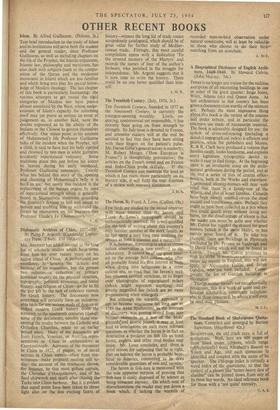A Biographical Dictionary of English Archi- tects, 1600 - 1840. By Howard
Colvin. (John Murray. 70s.) THERE is no longer any excuse for the reckless ascription of all interesting buildings to one
or other of the great quartet: Inigo Jones,
Wren, Adams (sic) and Queen Anne. At last architecture in this country has been
given a documentation worthy of the mistress art. Perhaps the most impressive thing about this book is the variety of the sources laid under tribute, and in particular the extensive use made of manuscript material. The book is admirably designed for use: the system of cross-referencing (including a detailed topograph:cal index) is efficient and painless, while the publishers and Messrs. R. & R. Clark have produced a volume that handles easily, looks handsome, and exploits every . legitimate typographic device to
make it easy to find things. At the beginning there is an invaluable essay on the archi- tectural profession during the period, and at the end a series of lists of crucial office-,
holders, both in the Works and elsewhere. Exasperated identity-hunters will hear with relief that there is a family-tree of the Wyatts, and also of lesser families. Canards have been silently omitted—even the most 'ancient and troublesome ones. Perhaps they ought to have been collected in a pen where they could quack away without doing any harm, for the disadvantage of silence is that the reader can never be quite sure whether Mr. Colvin has rejected the canard for good reasons (which is the more likely), or has merely never heard of it. To take one example, there are buildings in Plymouth attributed by Dr. Peesner to Vanbrugh and to David Laing which will not be found in Colvin.. Though Mr. Colvin professes to
limit his gWm $ . career lay mainly in England, this will not apply to Alesemdro Galilee and James Gendon, who are both included.. Conse- ignteleonntilpet


































 Previous page
Previous page